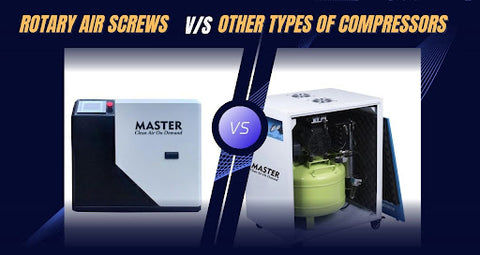Rotary Air Screws Compressor vs. Other Types of Compressors
Air compressors are some of the essential equipment needed at construction sites. There are numerous varieties of air compressors, each with certain advantages and disadvantages.
Based on their internal processes, air compressors can be classified as positive displacement or dynamic displacement. The most typical kinds of air compressors are as follows:
- Rotary Screw Compressors
- Reciprocating Air Compressors
- Dynamic Air Compressors
There are two types of Dynamic Air compressors
- Axial Compressors
- Centrifugal Compressors
Read on to discover the many different air compressor types and how rotary screw air compressors differ.
Rotary Screw Air Compressors
One popular class of displacement compressors with an internal cooling system is the rotary screw compressor. This air compressor is a large-sized industrial device that can operate with or without oil lubrication. Rotary screw compressors range from 25 HP to 600 HP, depending on the design. These compressors are less noisy. These air compressors can produce high-pressure ratios and are energy-efficient.
Reciprocating Compressors
Another well-known variety of displacement compressors is the reciprocating compressor. This air compressor is necessary for smaller work sites, such as garages and house construction projects. The reciprocating compressor is not intended for continuous usage, in contrast to the rotary screw compressor.
Single-acting and double-acting types of reciprocating compressors are available in the market. The piston only compresses the air on one side of a single-acting reciprocating compressor. In contrast, a double-acting reciprocating compressor would compress the air on both piston sides.
Dynamic Air Compressors
Dynamic air compressors raise the air pressure by forcing the air through rotating impellers. These compressors are appropriate for applications where completely oil-free air delivery is required. The two most prevalent types of dynamic compressors are axial and centrifugal compressors.
Construction projects do not often include the use of axial air compressors. Instead, they are typically discovered in the fast engines of ships and aircraft. Axial compressors are best used in aerospace applications because of their high-efficiency rate and high cost compared to other types of air compressors.
The centrifugal type of air compressor, which is currently the most popular type used in industrial applications, is one of the most significant. These compressors are more effective than rotary screw compressors, which fall under the positive displacement category of air compressors because they are built in a multi-stage process.
These compressors are used in turbochargers in the oil and gas sectors. They work best in applications requiring 250 HP or more, though they can reach upwards of 6K HP in some circumstances.

Rotary Air Screws vs. Reciprocating Compressors
- Reciprocating air compressors have a 20-30% duty cycle, whereas rotary screw compressors have a 100% duty cycle.
- Compared to reciprocating air compressors, rotary screw compressors have more durability and a longer lifespan.
- Reciprocating compressors generate noise, whereas rotary screw compressors perform silently.
- Reciprocating compressors are less expensive and capable of high pressures.
- Reciprocating compressors require an air receiver tank, but rotary screw compressors don’t.
- Rotary screw compressors generate less heat compared to reciprocating compressors.
Rotary Air Screws vs. Dynamic Compressors
- Centrifugal compressors can supply oil-free air, which is suitable for sensitive applications.
- In contrast to axial compressors, centrifugal compressors have a larger frontal area for a given air flow rate.
- Compared to rotary screw compressors, centrifugal compressors are prone to surging, stalling, and choking.
- Centrifugal compressors are not suitable for very high compression.
- Axial flow compressors have peak efficiency compared to other types of compressors.
- However, axial compressors are more expensive compared to rotary screw compressors.
- The axial compressor is much more complicated to install compared to other compressors.
Conclusion
Selecting the ideal air compressor for your application involves several intricate considerations. Contact a certified expert at MasterAire to learn which air compressor is appropriate for your company.
Click here to explore our collection of high-performing air compressors. Or, call us to discuss your requirements!
Related Articles
Related Articles
-
![]()
Best Oil for Rotary Screw Air Compressors: ISO 46 or ISO 68?
-
![]()
Why Diesel Generators Are Essential During Florida's Hurricane Season
-
![]()
VFD vs VSD in Rotary Screw Air Compressors: What's the Real Difference?
-
![]()
Emissions Tiers for Diesel Generators in North America
-
![]()
The Essential Role of Diesel Generators for California Businesses Amid Power Outages
-
![]()
Essential Generator Maintenance Checklist for North American Summers
-
![]()
The Hidden Ingredient: Compressed Air Treatment and Food Safety
-
![]()
Enhancing Productivity: The Role of Air Compressors in Modern Manufacturing
-
![]()
Powering Industries: A Beginner’s Guide to Diesel Generators and Their Applications
-
![]()
Why Air Dryers Are Essential for Industrial Efficiency and Moisture Control
-
![]()
Natural Gas: A Bridge to the Renewable Power Generation Era
-
![]()
Purity Under Pressure: How Oil-Free Air Compressors Drive the Food and Beverage Industry















